Have you ever wondered, “why do ducks bob their heads?” Let’s dive into their world and unravel this interesting behavior together!
Ducks, our charming feathered friends, have a quirky behavior that never fails to catch our attention – head bobbing! But what exactly does it mean? Why do ducks engage in this unique behavior? Let’s explore the fascinating world of duck bobbing behavior and understand its significance.
Key Takeaways:
- Ducks bob their heads for various reasons, such as showing happiness, flirtation, and preparation for mating.
- Head bobbing is a positive behavior that indicates ducks are in a good place and ready to reproduce.
- Understanding duck behavior is crucial for being a responsible duck owner and recognizing signs of stress, like lethargy and reduced egg production.
- Ducks communicate through vocalizations, body language, and physical contact, and each type of movement has its own meaning and purpose.
- By understanding duck behavior, we can provide better care and communication with these fascinating creatures.
The Natural Behavior of Ducks
Ducks are known for their unique behavior, and head bobbing is one of the most common ways they communicate with each other. It is a fascinating natural behavior that showcases their social nature and their ability to convey messages among themselves.
Through head bobbing, ducks exhibit a range of emotions and intentions. When ducks are happy, they often make quacking noises and bob their heads up and down as a sign of contentment. This positive behavior indicates that they are in a good place and ready to engage with their surroundings.
Head bobbing also plays a significant role in courtship and mating rituals. Male ducks, eager to impress and attract females, may thrust their heads forward as a flirtatious gesture. This movement, along with other head movements like sideways bobs, head tilting, and tail wagging, helps male ducks establish their dominance and express their intentions.
Moreover, head bobbing is a form of non-verbal communication among ducks. In addition to vocalizations, ducks use body language and physical contact to express themselves. Understanding these behaviors is crucial for duck owners to provide better care and communication with their feathered companions.

Understanding the Purpose of Head Bobbing
Head bobbing plays a crucial role in duck courtship, with male ducks using this behavior to woo and mate with female ducks. It is a fascinating behavior that showcases their innate instincts and serves as a vital part of their mating rituals. When a male duck bobs its head, it is a clear indication that it is preparing for mating and is trying to attract the attention of a potential mate.
During courtship, male ducks will often bob their heads vigorously, sometimes with their bills pointed straight up in the air. This head movement not only helps them establish dominance but also serves as a way to communicate their intentions and readiness to reproduce. It is a flirtatious gesture that not only captures the interest of female ducks but also signals their ability to provide and protect.
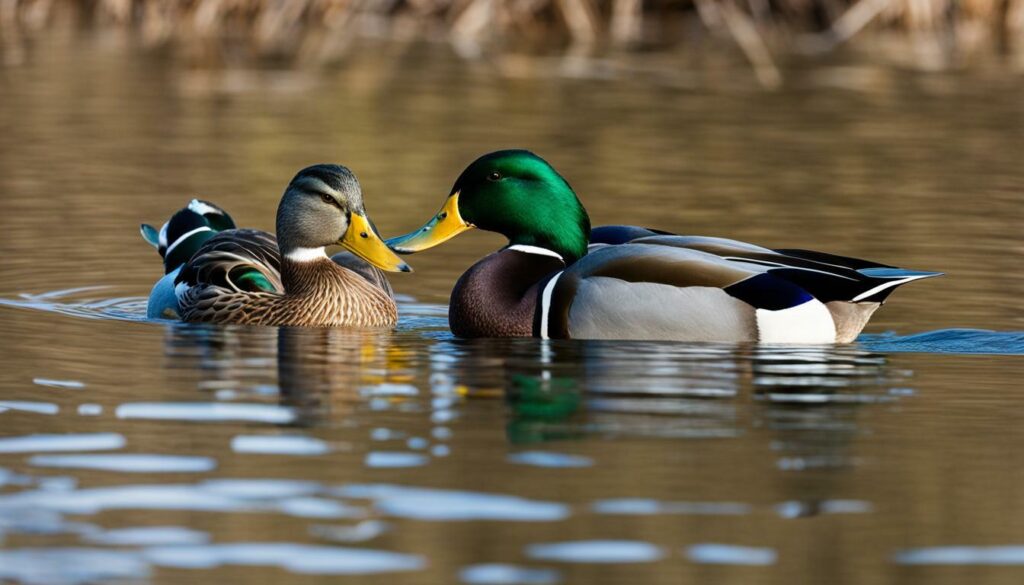
The purpose of head bobbing is particularly significant for female ducks as they rely on this behavior to assess the suitability of potential mates. They observe the intensity and consistency of head bobbing to gauge the male duck’s health, strength, and reproductive fitness. By observing this behavior, female ducks can determine if a male duck is fit to be their mate and capable of fathering healthy offspring.
Understanding the purpose of head bobbing in ducks is essential for individuals who own or work with these delightful creatures. It allows us to better comprehend their needs, behaviors, and preferences. By recognizing head bobbing as a natural behavior associated with courtship and mating, we can create an environment that supports and encourages the social interactions and reproductive success of these magnificent birds.
Bobbing as a Flirtatious Gesture
When it comes to courtship behavior, ducks know how to flirt, and head bobbing is one of their go-to gestures to catch the attention of a potential mate. It’s their way of saying, “Hey there, I’m interested!” Head bobbing is a flirtatious display that male ducks use to impress and attract female ducks. Think of it as their version of a suave pick-up line or a charming dance move.
Male ducks have mastered the art of head bobbing and use it to their advantage in the game of love. They show off their style by tilting their heads and bobbing them up and down with confidence. It’s a visually striking display that can’t be ignored.
But head bobbing isn’t just about up and down movements. Ducks are creative when it comes to flirting, and they also incorporate sideways head bobbing into their repertoire. This unique gesture adds a touch of playfulness to their courtship dance, making it even more irresistible to female ducks.

The Power of Bobbing
Head tilting is another head movement that male ducks use to show off their confidence and woo the ladies. They thrust their heads forward while maintaining eye contact, a bold move that demonstrates their dominance and impresses potential mates. A male duck who can tilt his head just right has a higher chance of catching the eye of a female duck and initiating a romantic connection.
So, if you ever find yourself in the presence of a male duck performing impressive head bobbing displays, know that he’s not just playing around. He’s actively engaged in the art of flirting, hoping to win over the heart of a female duck. It’s a fascinating behavior that demonstrates the creativity and charm of our feathered friends.
Signs of Happiness in Ducks
Happy ducks exhibit various behaviors, including enthusiastic quacking and rhythmic head bobbing up and down. These positive behaviors indicate that ducks are in a good place and content. It’s always a joy to see ducks expressing their happiness through these charming actions.
According to experts, quacking is a common behavior observed in happy ducks. It’s their way of vocalizing and communicating with other ducks in their flock. The quacking sounds are distinctive and can vary in tone and intensity, conveying different messages. Whether it’s for socializing or expressing excitement, quacking is a clear sign of a happy duck.
Another behavior often associated with ducks’ happiness is their rhythmic head bobbing up and down. This adorable movement is not only visually appealing but also serves as a way for ducks to communicate and interact with their surroundings. It’s their way of expressing curiosity, interest, and engagement with the environment.

Observing ducks bobbing their heads up and down can bring a smile to anyone’s face. It’s a fascinating display of their playful nature and contentedness. So the next time you see your ducks happily quacking and bobbing their heads, you can be assured that they are in a positive state of well-being.
Non-Verbal Communication in Ducks
Ducks have a diverse range of non-verbal communication methods, and their head movements play a crucial role in conveying messages to other ducks. Through their body language, vocalizations, and physical contact, ducks express their emotions, intentions, and establish social dynamics within their flock. Head movements, in particular, are a significant aspect of their non-verbal communication repertoire.
Head bobbing is one of the most common and noticeable head movements observed in ducks. It serves various purposes, including courtship behavior and establishing dominance. Male ducks often thrust their heads forward in a flirtatious gesture to impress female ducks and demonstrate their suitability as a mate. This head movement is accompanied by other actions like tail wagging and sideways head bobbing, creating an elaborate display of courtship.
In addition to head bobbing, ducks also tilt their heads to convey different messages. A sideways head tilt is often seen as a sign of curiosity or attentiveness. They may also use head movements to signal their intentions and establish dominance within their flock. These distinct head movements are a fascinating form of non-verbal communication that allows ducks to navigate their social interactions and convey their emotions to other ducks.
| Non-Verbal Communication Methods in Ducks | Meaning |
|---|---|
| Head Bobbing | Flirtation, courtship behavior |
| Sideways Head Tilt | Curiosity, attentiveness |
| Tail Wagging | Asserting dominance |
“Head movements are not just a random action for ducks, but an integral part of their communication. They use various head movements to convey their feelings, establish relationships, and navigate their social interactions. It’s a fascinating aspect of duck behavior that showcases their complex communication skills.”
Vocalizations also play a significant role in duck communication. Ducks produce a wide range of sounds, from quacks to hisses, to convey different messages to their flock. These vocalizations, combined with their body language and head movements, enable ducks to establish social hierarchies, attract mates, and maintain harmony within their group.
Understanding and interpreting the non-verbal communication methods of ducks is crucial for anyone caring for these beautiful creatures. By recognizing their different head movements, vocalizations, and body language, we can better understand their needs and provide appropriate care. It allows us to foster a deeper connection with our feathered friends and ensure their well-being in a domestic or natural environment.
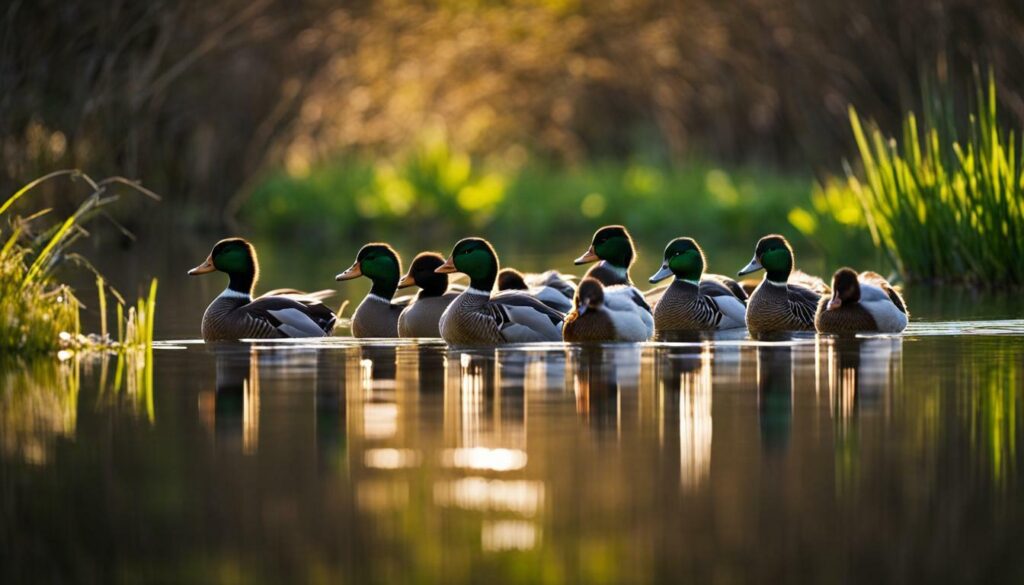
While head bobbing is a common behavior, ducks also engage in other fascinating movements, such as sideways head bobbing, bubble blowing, and tail wagging. These interesting behaviors can provide insights into their feelings and actions, adding to the charm and intrigue of these feathered creatures.
When ducks engage in sideways head bobbing, it’s as if they’re dancing to their own rhythm. This movement involves tilting their heads from side to side, almost like a gentle sway. It’s a captivating sight, and it can be observed in many duck species.
| Behavior | Description |
|---|---|
| Sideways Head Bobbing | A gentle tilting of the head from side to side. |
| Bubble Blowing | Blowing bubbles through their bills, creating a delightful spectacle. |
| Tail Wagging | Wagging their tail feathers from side to side, often accompanied by quacking noises. |
Additionally, ducks are known for their bubble-blowing skills. They create bubbles by blowing air through their bills while partially submerged in water. This not only adds a touch of playfulness to their behavior but also serves practical purposes, such as keeping their feathers clean.
Tail wagging is another intriguing behavior exhibited by ducks. This movement involves wagging their tail feathers from side to side, often accompanied by quacking noises. It is believed to be a way for ducks to communicate with each other or establish dominance within their flock.

These unique and playful movements showcase the diverse behaviors that ducks exhibit. From their sideways head bobbing to bubble blowing and tail wagging, ducks always find captivating ways to express themselves and communicate with one another.
Recognizing Signs of Stress in Ducks
It’s important to be vigilant and recognize signs of stress in ducks, as they can impact their overall health and happiness. Ducks, just like humans, can experience stress in various situations, and it’s crucial for their well-being that we as their caretakers understand and address their needs.
One of the primary indicators of stress in ducks is lethargy. If you notice your ducks being unusually inactive or spending more time resting than usual, it could be a sign of stress. Ducks may also exhibit reduced egg production when stressed. So, if you observe a sudden decline in egg-laying or irregular patterns, it’s essential to consider the possibility of stress as a contributing factor.
Stress in ducks can manifest in different ways, and it’s crucial to pay attention to their behavior. If you notice your ducks becoming agitated, aggressive, or displaying abnormal behavior, it’s likely an indication of stress. It’s also important to observe if they are eating and drinking properly, as changes in appetite or drinking habits can be signs of stress as well.
| Signs of Stress in Ducks | What to Look For |
|---|---|
| Lethargy | Unusual inactivity and increased resting |
| Reduced Egg Production | Sudden decline in egg-laying or irregular patterns |
| Agitation and Abnormal Behavior | Increased aggression, restlessness, or abnormal actions |
| Changes in Appetite and Drinking Habits | Loss of appetite or increased drinking |
If you suspect that your ducks may be stressed, it’s essential to provide them with a calm and conducive environment. Ensuring they have access to fresh water, a balanced diet, and a clean living space can help alleviate stress. Additionally, providing enrichment activities, such as toys or a small pool for them to swim in, can help reduce stress levels.
Remember, as caretakers, our role is to ensure the well-being and happiness of our ducks. By recognizing and addressing signs of stress, we can create a healthier and more comfortable environment for our feathered friends.
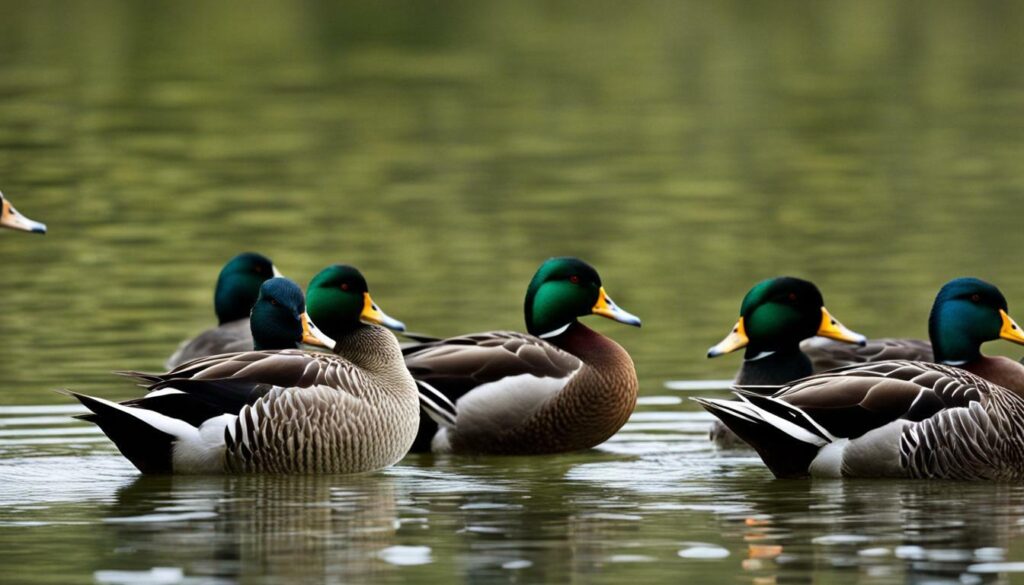
- Be vigilant and recognize signs of stress in ducks to ensure their overall health and happiness.
- Signs of stress in ducks include lethargy, reduced egg production, agitation, abnormal behavior, and changes in appetite and drinking habits.
- Provide a calm environment, fresh water, a balanced diet, and enrichment activities to help alleviate stress in ducks.
Importance of Understanding Duck Behavior
By gaining a deeper understanding of duck behavior, you can ensure that you are meeting the needs of your ducks and fostering a positive relationship with them. Ducks are unique creatures with their own set of behaviors and communication methods. When you take the time to learn about their behaviors, you’ll be better equipped to provide the care and attention they require.
Understanding duck behavior goes beyond simply knowing why they bob their heads or make quacking noises. It involves recognizing their body language, interpreting their vocalizations, and knowing how they interact with other ducks. This knowledge enables you to create a suitable environment for your ducks, address any potential stressors they may face, and ensure their overall well-being.
As a duck owner, you have the responsibility to meet their physical and emotional needs. Ducks thrive in environments that mimic their natural habitats, and understanding their behavior can help you create such a space. By observing and interpreting their behaviors, you can ensure they have enough space to move, access to clean water for swimming, and suitable shelter to protect them from the elements.

| Benefits of Understanding Duck Behavior |
|---|
| Avoiding stress-related issues such as reduced egg production |
| Recognizing signs of happiness and contentment |
| Building trust and fostering a positive relationship with your ducks |
| Creating a suitable environment that meets their needs |
| Enhancing communication and bonding with your ducks |
Furthermore, understanding duck behavior allows you to recognize signs of stress in your ducks. Stress can manifest in various ways, such as through lethargy or reduced egg production. By being aware of these signs, you can take immediate action to address the underlying causes and ensure your ducks’ well-being.
Ultimately, gaining a deeper understanding of duck behavior leads to better care and communication with your ducks. It opens the door to a more fulfilling and enriching relationship with these fascinating creatures. So take the time to observe, learn, and engage with your ducks, and you’ll be rewarded with a harmonious and joyous partnership.
The Fascinating World of Duck Communication
Ducks have a complex system of communication, utilizing vocalizations and physical gestures to interact and maintain social harmony within their flock. These incredible creatures have developed unique ways of conveying messages and establishing connections with other ducks. From quacking and head movements to body language and physical contact, ducks have a rich repertoire of communication methods.
One of the most common ways ducks communicate is through vocalizations. They use a variety of quacks, honks, and whistles to express themselves. These vocalizations can convey different messages, such as warnings, greetings, or expressions of contentment. The rhythm, tone, and volume of their calls can provide important insights into their current state and intentions.
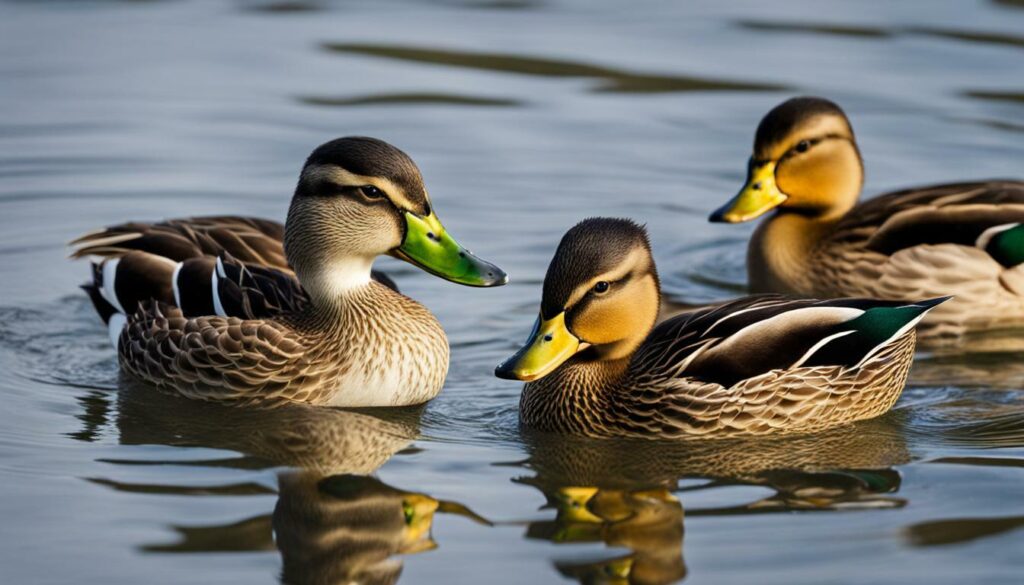
In addition to vocalizations, ducks use physical gestures to communicate. Their head movements play a significant role in expressing various emotions and intentions. For example, a duck may bob its head up and down to show happiness and contentment. This rhythmic movement indicates that the duck is in a positive state of mind and is at ease.
Table: Common Duck Communication Behaviors
| Behavior | Description |
|---|---|
| Head Bobbing | A rhythmic up and down movement that indicates happiness and contentment. |
| Quacking | A vocalization that can convey different messages, such as greetings or warnings. |
| Head Thrusting | A forward movement of the head to impress a mate or establish dominance. |
Physical contact is another essential aspect of duck communication. Ducks often engage in gentle touching, preening, and nibbling as a way to strengthen social bonds and express affection. These tactile interactions help maintain social harmony within the flock and reinforce their connections with one another.
By understanding the various communication methods ducks use, we can better care for and communicate with these remarkable creatures. Whether it’s observing their head movements, listening to their vocalizations, or appreciating their physical gestures, being attuned to their communication signals allows us to build a deeper connection with our feathered friends.
Exploring Head Movements in Ducks
Ducks are masters of head movements, with their ability to move their heads from side to side or bob them on the surface of the water. These fascinating movements serve various purposes and are observed in many duck species. Head movements are not only a means of communication for ducks but also a way of expressing their emotions and asserting dominance.
When ducks move their heads from side to side, it is often a sign of curiosity or alertness. They use this behavior to scan their surroundings and keep a watchful eye for potential threats. It’s their way of staying vigilant and ensuring their safety in their natural habitats. You might notice ducks bobbing their heads in unison, almost as if they’re synchronized, creating a mesmerizing sight.
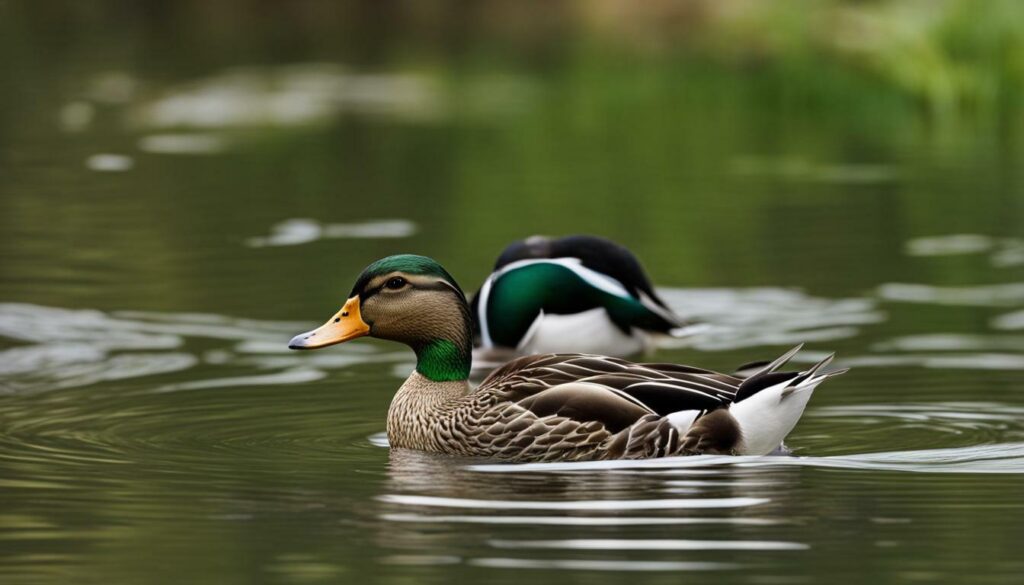
Another common head movement in ducks is bobbing them on the surface of the water. This behavior is often associated with feeding. Ducks dip their heads underwater to search for food, such as insects or aquatic plants. Their ability to bob their heads helps them reach underwater while keeping their bodies afloat. It’s an efficient technique that allows them to maximize their food intake and survive in their natural habitats.
Duck head movements are not only fascinating to observe but also provide valuable insights into their behavior and emotions. Understanding these movements can help us better care for and communicate with these remarkable creatures, ensuring they lead happy and healthy lives.
Bobbing Heads: A Way of Life for Ducks
Head bobbing is a natural behavior deeply ingrained in the world of ducks, and it is one of the most common ways they communicate. Ducks engage in this fascinating behavior for various reasons, using it as a means to show happiness, flirtation, and prepare for mating. It’s a positive behavior that indicates they are in a good place and ready to reproduce. When you see ducks happily bobbing their heads up and down, it’s a sure sign that they are content and thriving.

As a responsible duck owner, understanding the behavior of ducks is crucial. It helps you provide better care and communication with your feathered friends. Recognizing signs of stress, such as lethargy and reduced egg production, allows you to take appropriate action and ensure the well-being of your ducks. By paying attention to their head movements, quacking noises, and overall behavior, you can gauge their happiness and address any concerns that may arise.
Aside from the adorable head bobbing up and down, ducks have a wide range of other movements that convey different messages. From sideways bobs and bubble blowing to head tilting and tail wagging, each movement reveals specific feelings and actions. By observing these behaviors, you can gain insight into your ducks’ mood and intentions. Additionally, ducks communicate through vocalizations, body language, and physical contact, providing further means of understanding their needs and emotions.
| Duck Behavior | Meaning |
|---|---|
| Sideways bobbing | Curiosity or surprise |
| Bubble blowing | Contentment or playful mood |
| Head tilting | Attention or interest |
| Tail wagging | Excitement or aggression |
By familiarizing yourself with these behaviors and their meanings, you can develop a deeper connection with your ducks and ensure their well-being. Understanding the fascinating world of duck behavior allows you to provide the care and attention they need, making your relationship with these feathered companions even more rewarding.
Head Bobbing as a Mating Ritual
Head bobbing serves as a crucial element of the mating ritual in ducks, with male ducks using this behavior to woo and court potential mates. It is a fascinating display that showcases their vibrant personalities and unique courtship strategies. When a male duck spots a female that catches his eye, he will often engage in head bobbing as a way to capture her attention and communicate his interest.
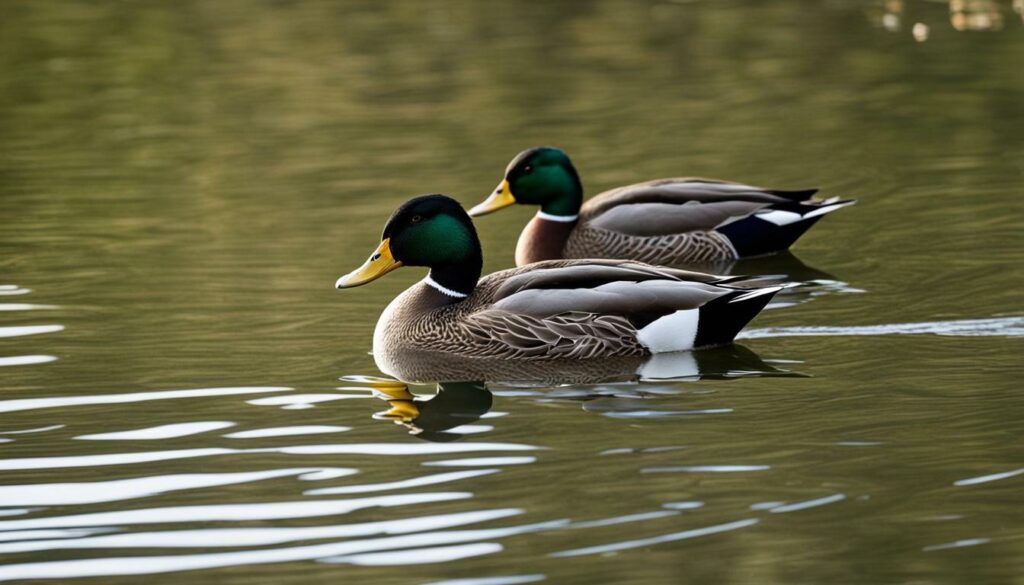
During the courtship process, male ducks may also perform other captivating movements, such as thrusting their heads forward or flapping their wings, to impress the female and establish their dominance. These gestures, combined with head bobbing, create a mesmerizing dance that aims to win over the female’s affections.
Head bobbing can also serve as a means for male ducks to showcase their physical fitness and overall attractiveness. The frequency, speed, and intensity of their head movements can convey important information about their vitality and genetic quality, helping the female make an informed decision when choosing a potential mate.
Table: Duck Head Movements During Courtship
| Head Movement | Description |
|---|---|
| Head Bobbing | Rapid up and down movement of the head to catch the female’s attention. |
| Head Thrusting | Forceful forward movement of the head to impress the female and establish dominance. |
| Wing Flapping | Enthusiastic flapping of the wings to display physical fitness. |
As female ducks observe these elaborate courtship displays, they carefully assess the males’ behaviors, searching for a suitable partner to ensure successful reproduction. The males that can execute the most captivating and energetic head bobbing rituals have a higher chance of attracting a mate and passing on their genes to the next generation.
Broody Females and Bobbing Heads
Broody females, ready to incubate their eggs, display their maternal instincts through head bobbing up and down. This unique behavior is a sign that these ducks are preparing to embark on their crucial role of nurturing and hatching their eggs. As a duck owner, witnessing this head bobbing can be both fascinating and rewarding, as it signifies the beginning of new life within your flock.
During the brooding period, female ducks will often bob their heads up and down in a rhythmic motion. This gentle movement helps them to create a safe and comfortable nest for their eggs. By bobbing their heads, they are able to adjust the position of the eggs and ensure that they are properly situated for incubation. This behavior also aids in regulating the temperature and humidity levels within the nest, providing an optimal environment for the developing embryos.
As the broody female continues to bob her head, she is instinctively communicating with her unhatched ducklings. This rhythmic movement serves as a way for her to bond with her offspring even before they hatch. It is a remarkable display of the maternal instincts that ducks possess, as they take on the responsibility of caring for and protecting their young.
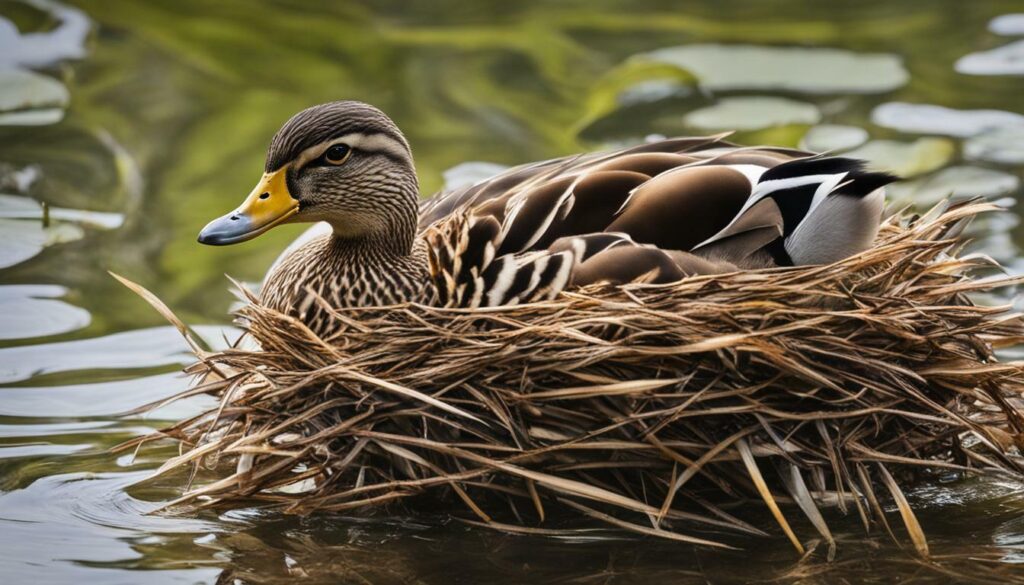
| Broody Female Behavior | Explanation |
|---|---|
| Head bobbing up and down | Preparation for incubating eggs and creating a comfortable nest. |
| Rhythmic movements | Regulating temperature and humidity levels within the nest. |
| Bonding with unhatched ducklings | Establishing a connection and communication with her offspring. |
Observing broody females as they bob their heads is a testament to the incredible instincts and nurturing nature of ducks. It is essential to provide broody females with a safe and quiet space to incubate their eggs, ensuring they have the support and environment they need to successfully hatch their ducklings. By understanding and appreciating this fascinating behavior, you can better care for and support the brooding process, resulting in healthy and happy duck families.
The Intriguing World of Duck Behavior
Ducks are fascinating creatures with a rich repertoire of behaviors, making them a captivating subject of study for anyone interested in the natural world. From their head bobbing antics to their vocalizations and physical gestures, ducks are known for their interesting behavior. These social animals engage in a variety of actions to communicate with each other, establish dominance, and seek out potential mates.
One of the most common and charming behaviors ducks exhibit is head bobbing. This rhythmic movement is often a sign of happiness and contentment. Ducks may also engage in head bobbing as a flirtatious gesture, particularly when trying to impress a potential mate. This behavior, along with quacking noises and head bobbing up and down, indicates that the duck is in a good place and ready to reproduce.
In addition to head bobbing, ducks display various other movements and behaviors that have different meanings. Sideways head bobbing, head tilting, and tail wagging are just a few examples of the interesting behaviors observed in ducks. Each movement conveys different feelings and actions, allowing ducks to express themselves within their flock.
Understanding duck behavior is crucial for anyone who owns or interacts with these fascinating creatures. By recognizing signs of stress, such as lethargy and reduced egg production, we can ensure the well-being of our feathered friends. Moreover, being aware of their behaviors allows for better care and communication, leading to a stronger bond and happier ducks.
FAQ
Why do ducks bob their heads?
Ducks bob their heads for various reasons, including to show happiness, flirtation, and preparation for mating.
What does it mean when ducks bob their heads?
When ducks bob their heads, it is a positive behavior that indicates they are in a good place and ready to reproduce.
How can I recognize signs of stress in ducks?
Signs of stress in ducks include lethargy and reduced egg production. It is important to understand these signs to ensure the well-being of your ducks.
Do happy ducks make any specific noises?
Yes, happy ducks make lots of quacking noises. They may also bob their heads up and down as a sign of contentment.
How do ducks use head bobbing to impress a female?
Male ducks may thrust their heads forward or engage in sideways head bobbing to impress a female duck or establish dominance.
What are some other movements ducks make?
Ducks may engage in bubble blowing, head tilting, tail wagging, and other head movements, each indicating different feelings and actions.
How do ducks communicate with each other?
Ducks communicate through vocalizations, body language, and physical contact, using a combination of these methods to express themselves.
Why is it important to understand duck behavior?
Understanding duck behavior is crucial for being a good owner and providing better care and communication with ducks.
How do ducks communicate within their flock?
Ducks use a combination of vocalizations, body language, and physical gestures to maintain social dynamics and communication within their flock.
How do ducks move their heads?
Ducks can move their heads from side to side, bob their heads on the surface of the water, and engage in various head movements observed in different duck species.

